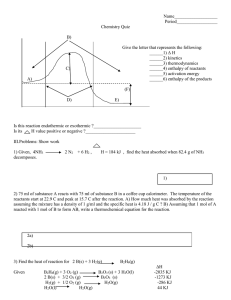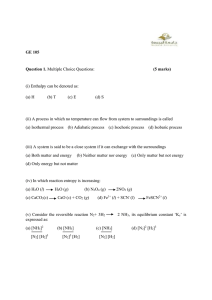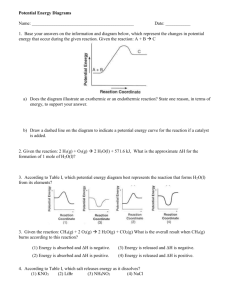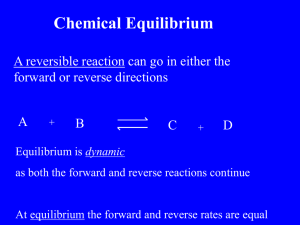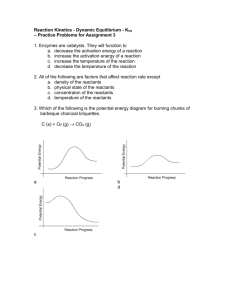Reaction Rate How Fast Does the Reaction Go?
advertisement
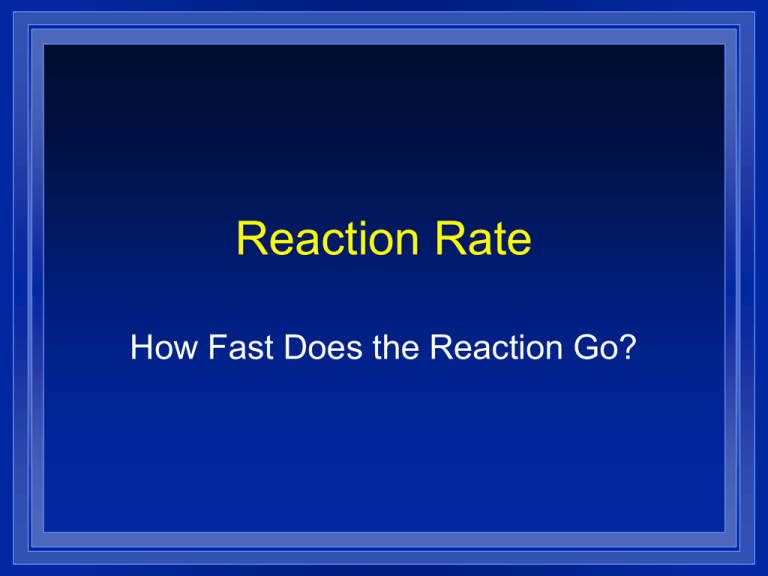
Reaction Rate How Fast Does the Reaction Go? Collision Theory In order to react molecules and atoms must touch each other. They must hit each other hard enough to react. – Must break bonds Anything that increases how often and how hard will make the reaction faster. Energy Reactants Products Reaction coordinate Energy Activation Energy Minimum energy to make the reaction happen – how hard Reactants Products Reaction coordinate Energy Activated Complex or Transition State Reactants Products Reaction coordinate Activation Energy Must be supplied to start the reaction Low activation energy – Lots of collision are hard enough – fast reaction High Activation energy – Few collisions hard enough – Slow reaction Activation energy If reaction is endothermic you must keep supplying heat If it is exothermic it releases energy That energy can be used to supply the activation energy to those that follow Energy Reactants Overall energy change Products Reaction coordinate Things that Affect Rate Temperature – Higher temperature faster particles. – More and harder collisions. – Faster Reactions. Concentration – More concentrated molecules closer together – Collide more often. – Faster reaction. Things that Affect Rate Particle size – Molecules can only collide at the surface. – Smaller particles bigger surface area. – Smaller particles faster reaction. – Smallest possible is molecules or ions. – Dissolving speeds up reactions. – Getting two solids to react with each other is slow. Things that Affect Rate Catalysts- substances that speed up a reaction without being used up.(enzyme). Speeds up reaction by giving the reaction a new path. The new path has a lower activation energy. More molecules have this energy. The reaction goes faster. Inhibitor- a substance that blocks a catalyst. Energy Reactants Products Reaction coordinate Catalysts H H Hydrogen bonds to surface of metal. Break H-H bonds H H Pt surface H H H H Catalysts H H H C C H H H H H Pt surface Catalysts The double bond breaks and bonds to the catalyst. H H H C H C H H Pt surface H H Catalysts The hydrogen atoms bond with the carbon H H H C H C H H Pt surface H H Catalysts H H H H C C H H H Pt surface H Reversible Reactions 2H2(g) + O2(g) 2H2O(g) + energy + energy 2H2(g) + O2(g) 2H2(g) + O2(g) 2H2O(g) + energy 2H2O(g) Equilibrium When you first put reactants together the forward reaction starts. Since there are no products there is no reverse reaction. As the forward reaction proceeds the reactants are used up so the forward reaction slows. The products build up, and the reverse reaction speeds up. Equilibrium Eventually you reach a point where the reverse reaction is going as fast as the forward reaction. This is dynamic equilibrium. The rate of the forward reaction is equal to the rate of the reverse reaction. The concentration of products and reactants stays the same, but the reactions are still running. Equilibrium Equilibrium position- how much product and reactant there are at equilibrium. Catalysts speed up both the forward and reverse reactions so do not affect equilibrium position. Just get you there faster Measuring equilibrium At equilibrium the concentrations of products and reactants are constant. We can write a constant that will tell us where the equilibrium position is. Keq equilibrium constant coefficients Keq = [Products] [Reactants]coefficients Square brackets [ ] means concentration in molarity (moles/liter) Writing Equilibrium Expressions General equation aA + bB Keq cC + dD = [C]c [D]d [A]a [B]b Write the equilibrium expression for this reactions. 3H2(g) + N2(g) 2NH3(g) Writing Equilibrium Expressions 3H2(g) + N2(g) Keq = [NH3]2 [H2]3 [N2] 2NH3(g) Calculating Equilibrium Keq is the equilibrium constant, it is only effected by temperature. Calculate the equilibrium constant for the following reaction. 3H2(g) + N2(g) 2NH3(g) if at 25ºC there 0.15 mol of N2 , 0.25 mol of NH3 , and 0.10 mol of H2 in a 2.0 L container. Calculating Equilibrium Calculate molarity [H2] = 0.10 mol of H2 2.0 L [N2] = 0.15 mol of N2 2.0 L [NH3] = 0.25 mol of NH3 2.0 L Calculating Equilibrium Keq = [NH3]2 [H2]3 [N2] Keq = [.125 M]2 [.05 M]3 [.075 M] Keq = 1667 What it tells us If Keq > 1 Products are favored – More products than reactants at equilibrium If Keq < 1 Reactants are favored LeChâtelier’s Principle Regaining Equilibrium LeChâtelier’s Principle If something is changed in a system at equilibrium, the system will respond to relieve the stress. Three types of stress are applied. – Changing concentration – Changing temperature – Changing pressure Changing Concentration If you add reactants (or increase their concentration). The forward reaction will speed up. More product will form. Equilibrium “Shifts to the right” Reactants products Changing Concentration If you add products (or increase their concentration). The reverse reaction will speed up. More reactant will form. Equilibrium “Shifts to the left” Reactants products Changing Concentration If you remove products (or decrease their concentration). The reverse reaction will slow down. More product will form. Equilibrium reverse“Shifts to the right” Reactants products Changing Concentration If you remove reactants (or decrease their concentration). The forward reaction will slow down. More reactant will form. Equilibrium “Shifts to the left”. Reactants products Used to control how much yield you get from a chemical reaction. Changing Temperature Reactions either require or release heat. Endothermic reactions go faster at higher temperature. Exothermic go faster at lower temperatures. All reversible reactions will be exothermic one way and endothermic the other. Changing Temperature As you raise the temperature the reaction proceeds in the endothermic direction. As you lower the temperature the reaction proceeds in the exothermic direction. Reactants + heat Products at high T Reactants + heat Products at low T H2O (l) H2O(s) + heat Changes in Pressure As the pressure increases the reaction will shift in the direction of the least gases. At high pressure 2H2(g) + O2(g) 2 H2O(g) At low pressure 2H2(g) + O2(g) 2 H2O(g) Low pressure to the side with the most gases. Two Questions How Fast? – Depends on collisions and activation energy – Affected by • Temperature • Concentration • Particle size • Catalyst Reaction Mechanism – steps Keq = How far? – Equilibrium • Forward and reverse rates are equal • Concentration is constant – Equilibrium Constant • One for each temperature – LeChâtelier’s Principle CO2 (g) + C (g) + heat ↔ 2 CO (g) Inc. CO2 Dec. CO Inc. heat Inc. Pressure Decrease [C] Hess’s Law Enthalpy is a state function. It is independent of the path. We can add equations to to come up with the desired final product, and add the DH Two rules If the reaction is reversed the sign of DH is changed If the reaction is multiplied, so is DH Standard Enthalpy The enthalpy change for a reaction at standard conditions (25ºC, 1 atm , 1 M solutions) Symbol DHº When using Hess’s Law, work by adding the equations up to make it look like the answer. The other parts will cancel out. Calculate ΔH for the reaction 4 NH3 (g) + 5 O2 (g) 4 NO (g) + 6 H2O (g), from the following data. N2 (g) + O2 (g) → 2 NO (g) ΔH = -180.5 kJ N2 (g) + 3 H2 (g) → 2 NH3 (g) ΔH = -91.8 kJ 2 H2 (g) + O2 (g) → 2 H2O (g) Δ H = -483.6 kJ 4 NH3 (g) + 5 O2 (g) 4 NO (g) + 6 H2O (g) N2 (g) + O2 (g) → 2 NO (g) ΔH = -180.5 kJ N2 (g) + 3 H2 (g) → 2 NH3 (g) ΔH = -91.8 kJ 2 H2 (g) + O2 (g) → 2 H2O (g) Δ H = -483.6 kJ 4 NH3 (g) + 5 O2 (g) 4 NO (g) + 6 H2O (g) N2 (g) + O2 (g) → 2 NO (g) ΔH = -180.5 kJ N2 (g) + 3 H2 (g) → 2 NH3 (g) ΔH = -91.8 kJ 2 H2 (g) + O2 (g) → 2 H2O (g) Δ H = -483.6 kJ 2 N2 (g) + 2 O2 (g) → 4 NO (g) ΔH = 2 (-180.5 kJ) 4 NH3 (g) + 5 O2 (g) 4 NO (g) + 6 H2O (g) N2 (g) + O2 (g) → 2 NO (g) ΔH = -180.5 kJ N2 (g) + 3 H2 (g) → 2 NH3 (g) ΔH = -91.8 kJ 2 H2 (g) + O2 (g) → 2 H2O (g) Δ H = -483.6 kJ 2 N2 (g) + 2 O2 (g) → 4 NO (g) ΔH = 2 (-180.5 kJ) 4 NH3 (g) → 2 N2 (g) + 6 H2 (g) ΔH = 2 (+91.8 kJ) 4 NH3 (g) + 5 O2 (g) 4 NO (g) + 6 H2O (g) N2 (g) + O2 (g) → 2 NO (g) ΔH = -180.5 kJ N2 (g) + 3 H2 (g) → 2 NH3 (g) ΔH = -91.8 kJ 2 H2 (g) + O2 (g) → 2 H2O (g) Δ H = -483.6 kJ 2 N2 (g) + 2 O2 (g) → 4 NO (g) ΔH = 2 (-180.5 kJ) 4 NH3 (g) → 2 N2 (g) + 6 H2 (g) ΔH = 2 (+91.8 kJ) 6 H2 (g) + 3 O2 (g) → 6 H2O (g) ΔH = 3 (-483.6 kJ) 4 NH3 (g) + 5 O2 (g) 4 NO (g) + 6 H2O (g) 2 N2 (g) + 2 O2 (g) → 4 NO (g) ΔH = 2 (-180.5 kJ) 4 NH3 (g) → 2 N2 (g) + 6 H2 (g) ΔH = 2 (+91.8 kJ) 6 H2 (g) + 3 O2 (g) → 6 H2O (g) ΔH = 3 (-483.6 kJ) 4 NH3 (g) + 5 O2 (g) 4 NO (g) + 6 H2O (g) 2 N2 (g) + 2 O2 (g) → 4 NO (g) ΔH = 2 (-180.5 kJ) 4 NH3 (g) → 2 N2 (g) + 6 H2 (g) ΔH = 2 (+91.8 kJ) 6 H2 (g) + 3 O2 (g) → 6 H2O (g) ΔH = 3 (-483.6 kJ) 4 NH3 (g) + 5 O2 (g) 4 NO (g) + 6 H2O (g) 2 N2 (g) + 2 O2 (g) → 4 NO (g) ΔH = 2 (-180.5 kJ) 4 NH3 (g) → 2 N2 (g) + 6 H2 (g) ΔH = 2 (+91.8 kJ) 6 H2 (g) + 3 O2 (g) → 6 H2O (g) ΔH = 3 (-483.6 kJ) 4 NH3 (g) + 5 O2 (g) 4 NO (g) + 6 H2O (g) 2 N2 (g) + 2 O2 (g) → 4 NO (g) ΔH = 2 (-180.5 kJ) 4 NH3 (g) → 2 N2 (g) + 6 H2 (g) ΔH = 2 (+91.8 kJ) 6 H2 (g) + 3 O2 (g) → 6 H2O (g) ΔH = 3 (-483.6 kJ) 4 NH3 (g) + 5 O2 (g) → 4 NO (g) + 6 H2O (g) ΔH = -1628. kJ Standard Enthalpies of Formation Hess’s Law is much more useful if you know lots of reactions. There are tables of standard heats of formation. The amount of heat needed to for 1 mole of a compound from its elements in their standard states. Standard states are 1 atm, 1 M and 25ºC For an element it is 0 Standard Enthalpies of Formation We can use heats of formation to figure out the heat of reaction. ( DH of products) - ( DH of reactants) = DH o Standard Enthalpies of Formation Use standard enthalpies of formation to determine the change in enthalpy for this reaction. ΔHf NaOH(s) = -426.7 (kJ/mol) ΔHf HCl(g) = -92.3 (kJ/mol) ΔHf NaCl(s) = -411.0 (kJ/mol) ΔHf H2O(g) = -241.8 (kJ/mol) NaOH(s) + HCl(g) → NaCl(s) + H2O(g) Standard Enthalpies of Formation o o o ( DH f products) - ( DH f reactants) = DH ∆H = [-411.0 kJ + -241.8 kJ] – [-426.7 kJ + -92.3 kJ] = -133.8 kJ
